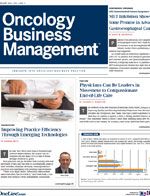Oral Chemotherapy Use Benefits From Safety Self-Assessments
The Institute for Safe Medication Practices (ISMP) and the Institute for Safe Medication Practices Canada (ISMP Canada) worked collaboratively to create a self-assessment tool to assist oncologists in evaluating safe practices related to medication use.
Safe medication management is a crucial aspect of patient care. That’s especially true in patients with cancer who are particularly vulnerable to medication mishaps, given the high-risk nature of the medications used in their treatment.
To address this concern, the Institute for Safe Medication Practices (ISMP) and the Institute for Safe Medication Practices Canada (ISMP Canada) worked collaboratively to create a self-assessment tool to assist oncologists in evaluating safe practices related to medication use. The final version of the tool consists of 175 self-assessment items, according to the study published in the Journal of Oncology Pharmacy Practice.1
“This tool will allow community oncologists to conduct their own risk assessment,” said Carole R. Chambers, BSc(Pharm), MBA, of the International Society of Oncology Pharmacy Practitioners (ISOPP) and one of the authors of the study. “The assessment provides the known risks and allows the oncologist to see where he stacks up against his peers.”
Oncology practice in most developed countries is similar, she went on, so testing the tool internationally to determine how well it performed and how well it was received was an added benefit.
Previously, ISMP and ISMP Canada had created medication safety self-
assessments for acute care hospitals. After conducting low-level surveys of their membership, it became apparent that “practice management techniques in oncology were pretty congruent.”
In addition, adverse outcomes associated with chemotherapy errors have been widely reported in the literature and the media. For example, according to the World Health Organization (WHO), administration of vincristine via the intrathecal route instead of the intended intravenous (IV) route is known to have occurred 55 times worldwide between 1968 and 2007.2 Anecdotal reports have suggested that the actual number of misadministration incidents involving vincristine had reached 120 by 2014. Intrathecal administration of vincristine results in ascending myeloencephalopathy, causing severe pain, paralysis, coma, and, in most cases, death.3
In 2006, a patient in Canada received an infusion of high-dose fluorouracil over 4 hours that was intended for administration over 4 days. The patient died about 3 weeks later.4,5
These and other examples spurred the need for, and development of, an assessment tool to assist oncologists in identifying best practices for the safe use of oncology medications. The self-assessment tool was tested in a small number of international oncology practice settings before being launched online.
Oral Chemotherapy Agents
A self-risk assessment would be particularly helpful in oral chemotherapy. According to the study authors, fewer than half of the participants in the analysis indicated that safeguards for oral chemotherapy and biotherapy agents were similar to those in place for parenteral agents.
Regional results also play a role in safeguard practices, said the authors of the study. For example, 68.4% of respondents from Asia, Europe, and South America combined had safety-related processes in place, compared with 41.3% of United States respondents who reported similar safety practices.
According to the study, a misperception exists, however, on the part of both practitioners and patients that oral chemotherapy agents are safer than parenteral agents.
“The oncology market is moving towards the use of more oral chemotherapy medications. Safety risk assessment is becoming more relevant to the community oncologist,” Chambers said.
With traditional IV medications, the patient arrives at the infusion center for a weekly or monthly treatment. Dosing, monitoring, and all safety precautions are in place in the infusion center and the staff is prepared for any unexpected emergencies. But the situation changes with oral chemotherapy because the patient is now in control of when, where, and how the medication is handled and taken.
“The literature is starting to come out now—if you don’t have good adherence or compliance with your ordered dose, you may not get the disease outcomes that you are expecting,” Chambers said. It is easy for patients to misunderstand how they are supposed to take the medication, with the real possibility of increased toxicity and harm from errors.
The other concern with prescribing oral chemotherapy agents is that, unless there is a robust monitoring system in place, patients may not contact the physician’s office if they start experiencing side effects.
“You have the possibility of people going off the rails quicker than you would if patients were coming in for routine appointments,” Chambers warned.
Available Online
The self-assessment tool is available on the ISMP Canada web site: https://mssa.ismp-canada.org/oncology.
“Oncologists can go online and take the assessment and compare their findings to a baseline to see how their practice relates to everyone else’s practice,” Chambers said.
It is clear that patients are at risk for serious harm if high-alert medications such as chemotherapy and biotherapy agents are involved in medication incidents. Specific safety strategies, such as those proposed with the self-assessment tool, should be implemented to prevent such harmful events from occurring.
“When we talk about safety, I would prefer to mitigate risk, to take the steps proactively to minimize risk, rather than be in a reactive state when patient harm does happen,” concluded Chambers.
References
- Greenall J, Shastay A, Vaida AJ, et al. Establishing an international baseline for medication safety in oncology: findings from the 2012 ISMP international medication safety self-assessment for oncology. J Oncol Pharm Pract. 2015;21(1):26-35.
- Information Exchange System alert no. 115. Geneva, Switzerland: World Health Organization, http://www.who.int/patientsafety/highlights/PS_alert_115_vincristine.pdf. Accessed January 25, 2015.
- Burgess N. High-risk medication alert for vincristine injection. Appendix 3: literature review. Collingwood, Australia: Society of Hospital Pharmacists of Australia Federal Secretariat, 2005.
- Fluorouracil root cause analysis report. Toronto, ON: Institute for Safe Medication Practices Canada. http://www.ismp-canada.org/download/reports/FluorouracilIncidentMay2007.pdf. Accessed January 25, 2015.
- Fluorouracil root cause analysis: follow-up. ISMP Can Saf Bull. 2007;7:1-4. http://ismp-canada.org/download/safetyBulletins/ISMPCSB2007-04Fluorouracil.pdf. Accessed January 25, 2015.




